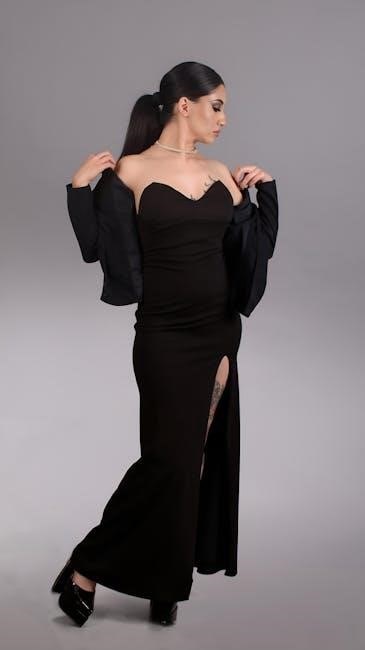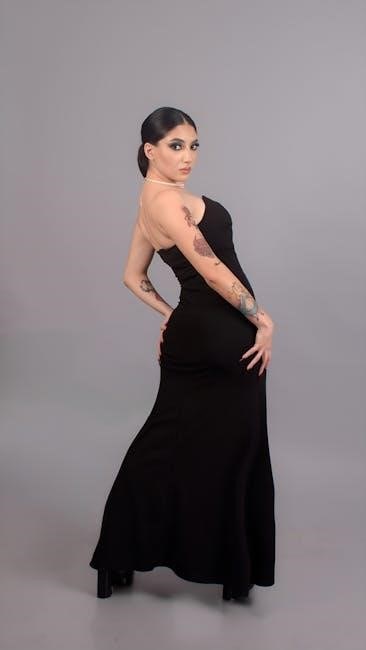Coat sizing is crucial for both comfort and style. A well-fitted coat ensures optimal warmth and mobility, while poor fit can compromise functionality and aesthetics. Correct sizing varies between brands and genders, requiring precise measurements for the best fit.
1.1 Importance of Correct Fit
A correct fit is essential for both comfort and style. A well-fitted coat ensures proper mobility and optimal warmth, while an ill-fitting one can restrict movement or appear unflattering. Correct sizing enhances confidence and satisfaction, making it a priority for any wardrobe investment. Whether for formal events or everyday use, a coat that fits perfectly balances aesthetics and functionality. Incorrect sizing can lead to issues like sleeves being too short or the coat feeling too tight, especially when layering; Investing time in accurate measurements and understanding size charts helps avoid these problems, ensuring a coat that complements your body and meets your needs year-round.

Key Measurements for Coat Sizing
Accurate measurements are vital for a perfect fit. Chest, shoulders, sleeve length, waist, and back length are the primary factors to consider when determining coat size. These measurements ensure proper fit and comfort.
2.1 Chest Measurement
The chest measurement is a critical factor in determining coat size, especially for men. It is typically measured around the fullest part of the chest, ensuring the tape is level and not too tight. For men, this measurement often dictates the coat size, while for women, it is compared alongside the bust measurement. Proper chest measurement ensures the coat can accommodate layers underneath without feeling restrictive. Brands may add inches to this measurement to account for a comfortable fit, with variations depending on the intended use of the coat, such as casual or formal wear.
2.2 Shoulder Measurement
The shoulder measurement is essential for ensuring the coat sits properly and allows for a full range of motion. It is measured from the base of the neck, across the shoulder, and down to the wrist, ensuring the tape is relaxed and not pulled tight. Accurate shoulder measurement prevents the coat from slipping off or feeling too restrictive. For men, this measurement is particularly important as it determines the fit across the upper body. Women’s coats may have slightly different shoulder measurements due to design variations. Proper shoulder fit ensures comfort and functionality, especially when layering clothing underneath. Using a flexible tape measure and keeping the arm slightly bent can help achieve precise results. This measurement, combined with chest size, forms the foundation for a well-fitting coat.
2.3 Sleeve Length Measurement
Sleeve length is a critical factor in coat sizing, ensuring comfort and style. Measure from the collarbone to the wrist, with the arm relaxed and slightly bent. Proper sleeve length prevents the coat from being too short or overly long, which can disrupt the overall fit. For men, sleeves should reach the thumbnail when arms are straight, while women’s coats may vary slightly. Layering affects sleeve length, so consider this when choosing a size. Using a flexible tape measure and ensuring the arm is at your side helps achieve accurate results. Correct sleeve length ensures the coat looks tailored and functions well, making it essential for a polished appearance and practical use.
2;4 Waist Measurement
The waist measurement is essential for achieving a tailored fit in coats, particularly for women, where it often determines the coat’s silhouette. Measure around the natural waistline, typically the narrowest point of the torso, just above the hips and below the ribs. Use a flexible tape measure and ensure it’s snug but not tight. For men, while chest size is often more critical, the waist measurement helps ensure the coat isn’t too tight or too loose. Accurate waist measurement is vital for styles like trenches or fitted coats, as it directly impacts both comfort and aesthetics. Always consider the coat’s design, as some styles may have a more relaxed or cinched waist. Proper sizing here ensures the coat drapes well and maintains a flattering shape.
2.5 Back Length Measurement
Back length measurement is critical for ensuring a coat fits properly, especially for taller individuals or those with longer torsos. Measure from the base of the neck, following the spine’s natural curve, to the desired coat hem. This length ensures the coat covers the body adequately without being too short or excessively long. Proper back length is essential for both style and functionality, as it impacts how the coat sits on the shoulders and aligns with the waist. For men, the standard back length typically ranges from 30 to 34 inches, while women’s coats may vary based on design, from cropped to maxi styles. Accurate measurement ensures a balanced, flattering silhouette and optimal coverage for warmth and comfort.

Measuring Techniques
Measuring techniques require a flexible tape measure, held level and snug, not tight. Stand upright, arms relaxed, and measure over underwear or a slim shirt for accuracy.
3.1 Best Practices for Accurate Measurements
For accurate coat measurements, use a flexible tape measure and stand upright in a relaxed position. Ensure the tape is level and not too tight. Measure over underwear or a slim shirt to reflect your body shape. When measuring your chest, wrap the tape around the fullest part, keeping it parallel to the floor. For shoulders, measure from one shoulder tip to the other across the back. Sleeve length is measured from the base of the neck, over the shoulder, and down to the wrist. Waist and back length should also be measured carefully. Always double-check your measurements to avoid errors. Using a full-length mirror can help ensure accuracy and proper alignment of the tape measure.
3.2 Using Existing Clothing as a Reference
Using existing clothing as a reference can simplify finding your coat size. Start by identifying a well-fitting jacket or coat. Check its size label and compare it to the brand’s size chart you’re shopping from. If the fit is consistent, you can use it as a baseline. For a more precise match, measure the garment itself. Lay the coat flat and measure the chest width, shoulder length, and sleeve length. Compare these measurements to the size chart of the coat you wish to purchase. This method helps account for brand-specific sizing variations and ensures a more accurate fit, especially when shopping online without the ability to try on the coat. This approach reduces the guesswork and enhances your confidence in selecting the right size.

Men’s vs. Women’s Coat Sizing
Mens and womens coat sizing differs in key measurements and fit. Mens sizing often focuses on chest size, while womens sizing considers bust and hip measurements for tailored fits.
4.1 Understanding Men’s Coat Sizing
Mens coat sizing primarily revolves around chest measurements, ensuring a comfortable and flattering fit. The chest size is typically the most critical dimension, as it determines the overall fit across the torso. Men’s coats are designed to accommodate layering, such as sweaters or dress shirts, so sizing charts often include a slight allowance for this. Shoulder measurements also play a significant role, as ill-fitting shoulders can drastically affect the coat’s appearance and comfort. Sleeve length is another key factor, measured from the collarbone to the wrist to ensure coverage and mobility. Additionally, some brands offer varying lengths, such as regular, long, or extra-long, to cater to different body types and preferences. Understanding these measurements helps in selecting a coat that not only fits well but also meets personal style needs.
4.2 Understanding Women’s Coat Sizing
Womens coat sizing emphasizes a balanced fit, focusing on bust, waist, and hip measurements to ensure comfort and style. Unlike mens sizing, womens coats often prioritize bust size as the primary measurement. However, waist and hip measurements also play a role, especially for tailored or fitted styles. The fit can vary significantly between brands, with some offering petite or plus sizes. Layering considerations are crucial, as womens coats may need to accommodate blouses, sweaters, or dresses. Understanding your body type and the coat style (e.g., oversized, fitted, or A-line) is key to selecting the right size. Referencing size charts and customer reviews can help navigate brand-specific variations and ensure the best fit. Proper sizing enhances both functionality and confidence, making it essential to measure accurately and choose wisely.

Brand Size Variations
Brand size variations arise from differing measurement standards, with some catering to specific body types while others prioritize fashion over fit. Always consult the brand’s size chart for accuracy.
5.1 Why Sizes Differ Across Brands
Differences in coat sizing across brands stem from varied measurement standards and target demographics. Some brands cater to specific body types or prioritize fashion over functionality, leading to discrepancies. Additionally, fabric type, intended use, and regional sizing norms contribute to size variations, making it essential for consumers to consult each brand’s size chart for accurate fit.
5.2 How to Compare Sizes Across Brands
To compare coat sizes across brands accurately, start by referencing each brand’s specific size chart, as sizing can vary significantly. Take your measurements beforehand, focusing on chest, waist, and sleeve length, which are critical for coat fit. Use these measurements to align with the brand’s sizing guidelines. Consider the intended fit—some brands offer slim, regular, or relaxed cuts. Additionally, read customer reviews to gauge how a particular brand’s sizes run, as some may be known for running small or large. If shopping internationally, look for size conversion charts to ensure consistency. Finally, utilize online size calculator tools that can help determine your best fit based on your measurements and preferences.

Layering Considerations
Layering affects coat sizing by requiring additional space for sweaters or blazers, ensuring comfort and mobility without compromising style or warmth. Proper fit accounts for layer thickness to avoid tightness.
6.1 Impact of Layering on Coat Size
Layering significantly impacts coat sizing, as additional clothing underneath requires more space for comfort and mobility. Thicker layers, such as sweaters or blazers, can add inches to your chest and shoulder measurements, making a larger coat size necessary to avoid tightness. Failing to account for layering can result in a coat that feels restrictive or even too small, limiting movement and comfort. This is especially true for winter coats, where bulky sweaters or multiple layers are common. Choosing a coat size that accommodates layers ensures a relaxed fit and optimal warmth, making it essential to consider layering needs when selecting your coat size. Proper sizing ensures both style and functionality, regardless of how many layers you wear underneath.
6.2 Tips for Choosing the Right Size with Layers
When selecting a coat size with layers in mind, consider the following tips:
Measure over layers: Take measurements while wearing your thickest layer to ensure accuracy.
Opt for a slightly larger size: Choose a coat one size larger than your shirt size to accommodate layers without feeling tight.
Check sleeve length: Ensure sleeves are long enough to cover your wrists, even when arms are extended.
Consider material and style: Thicker materials like wool may require a larger size, while trench coats or parkas are naturally roomier.
Compare sizing charts: Use brand-specific charts to adjust for variations in fit, as sizes can differ significantly.
By following these tips, you can find a coat that fits comfortably over layers, ensuring both style and functionality. Proper sizing guarantees optimal warmth and mobility, making layering effortless and enjoyable.

International Size Charts
International size charts help navigate differences in US, EU, and UK sizing, ensuring accurate fits across regions. They provide clarity for global shoppers, reducing size discrepancies and confusion.
7.1 Understanding US, EU, and UK Size Differences
Understanding the differences between US, EU, and UK sizing is essential for international shoppers. US sizes often use letter-based systems (S, M, L) and add inches to chest measurements for coat sizing. EU sizes typically follow a numerical scale, while UK sizes align closely with US measurements but may vary slightly. These discrepancies can lead to confusion when shopping across regions. For instance, a US medium may not equate to a UK or EU medium. To avoid size mismatches, refer to brand-specific size charts and conversion guides. Double-checking measurements ensures the best fit, especially when purchasing from international brands. This approach helps bridge the gap between regional sizing standards and personal fit preferences.

Using a Coat Size Calculator
A coat size calculator simplifies finding your ideal fit by using your measurements to recommend sizes. Input chest, waist, and sleeve length for accuracy. Ensure measurements are precise, as calculators vary by brand and style. Consider layering needs and verify recommendations against brand size charts for the best fit. Double-checking ensures comfort and proper sizing, making the calculator a valuable tool for confident purchasing decisions. Use it wisely to enhance your shopping experience and ensure your coat fits perfectly.
8.1 How to Use a Size Calculator Effectively
To use a coat size calculator effectively, start by gathering your measurements, including chest, waist, sleeve length, and back length. Ensure accuracy by measuring yourself or using a well-fitting coat as a reference. Input your data into the calculator, which will analyze your dimensions and recommend the ideal size. Consider layering needs; if you plan to wear thick sweaters, you may need to size up. Double-check the results against the brand’s size chart, as sizing can vary. Pay attention to sleeve length and shoulder fit, as these are critical for comfort. Finally, review customer reviews to confirm how the coat fits others with similar measurements. This method ensures a tailored fit and a seamless shopping experience.
8.2 Importance of Double-Checking Measurements
Double-checking measurements is essential to ensure accuracy and avoid size discrepancies. Small errors in measuring can lead to poor fit, making the coat either too tight or too loose. Always verify your measurements against the brand’s size chart, as sizing can vary significantly between brands. Layering requirements should also be considered; for example, if you plan to wear bulky sweaters, you may need a larger size. Additionally, customer reviews can provide insights into how a coat fits others with similar body types. By cross-referencing your measurements with size charts and reviews, you can confidently select the right size for comfort and style. This step ensures a seamless fit and minimizes the need for returns or alterations.

Customer Reviews and Fit
Customer reviews offer valuable insights into how a coat fits, helping you gauge sizing accuracy and comfort. Reading reviews can reveal if a coat runs true to size or if adjustments are needed. Feedback often highlights specific features like sleeve length, chest room, and overall comfort, ensuring a more informed purchase decision. This real-world advice complements size charts, providing a practical perspective on fit and style.
9.1 Analyzing Customer Reviews for Fit Insights
Customer reviews are a goldmine of information for determining coat fit. Many reviewers share detailed insights about sizing accuracy, comfort, and how the coat performs with layers. By reading through multiple reviews, you can identify common themes, such as whether a particular coat tends to run small or large. Pay attention to mentions of specific measurements, like chest size or sleeve length, as these can help you compare your own dimensions to others’ experiences. Additionally, reviewers often highlight features like ease of movement or how the coat sits on the shoulders, providing practical advice that goes beyond standard size charts. This real-world feedback can significantly enhance your ability to choose the right size for a comfortable and flattering fit.
9.2 Reading Product Descriptions for Size Clues
Product descriptions often contain valuable size clues that can help you make informed decisions. Look for specifics like chest measurements, sleeve lengths, and fit types (e.g., slim, oversized, or relaxed). Many descriptions mention whether the coat is designed to be worn over layers or as a standalone piece, which can influence sizing choices. Pay attention to fabric weight and stretch, as these factors can impact how the coat fits and feels. Some brands also include model measurements, providing a real-life reference point. By carefully reading these details, you can better align the coat’s features with your needs and body type, ensuring a more accurate fit without relying solely on the size chart.

Common Fit Issues and Solutions
Common fit issues include sleeves that are too short or a coat that feels too tight. Solutions often involve sizing up or adjusting measurements for layering.
10.1 Avoiding Sleeves That Are Too Short
Sleeves that are too short can restrict movement and compromise the coat’s functionality. To avoid this, measure sleeve length from the collarbone to the wrist. Ensure the measurement accounts for layering, as adding thickness from sweaters or blazers can make sleeves appear shorter. If sleeves are consistently too short, consider sizing up or opting for a longer style. Proper fit ensures comfort and mobility, especially for active use. Neglecting this can lead to a poor fit and discomfort. Always consult size charts and customer reviews for insights on sleeve length accuracy. Using a coat size calculator can also help determine the ideal fit based on your measurements and layering needs. This ensures sleeves are appropriately proportioned for your body and lifestyle.
10.2 Preventing the Coat from Being Too Tight
A coat that is too tight can restrict movement and compromise comfort. To prevent this, ensure accurate chest and shoulder measurements, as these are critical for a comfortable fit. Consider layering needs, as adding sweaters or blazers underneath can make the coat feel tighter. If you plan to wear heavy layers, size up to accommodate the extra bulk. Additionally, pay attention to fabric type, as heavier materials like wool may require a slightly larger size for comfort. Using a coat size calculator and reviewing customer feedback can provide insights into how a specific style fits. Prioritizing comfort ensures optimal mobility and satisfaction with your purchase. Always double-check measurements to avoid a snug fit that hinders ease of movement.
Choosing the right coat size is essential for comfort, style, and functionality. By understanding key measurements, such as chest, shoulders, and sleeve length, and considering factors like layering and brand variations, you can ensure a perfect fit. Utilizing size calculators and reviewing customer feedback can further guide your decision. Remember, sizing differs across brands and genders, so always consult specific size charts. Whether you’re shopping for a winter jacket, trench coat, or blazer, prioritizing accurate measurements and fit will enhance your overall experience. With these insights, you’ll be well-equipped to find a coat that meets your needs and provides long-lasting satisfaction.

